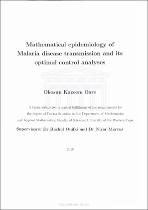| dc.description.abstract | In this thesis, we present and analyse an SEIR (susceptible-exposed infectious-recovered) model for malaria disease transmission. The model consists treatment and control strategies such as the use of bed nets and spray of insecticides with the costs associated with each control measure. Firstly, we analyse the model without treatment and investigate its stability and bifurcation behaviour. Then, we incorporate treatment and investigated the effects of different control strategies on the spread of malaria. Further, we use optimal control methods to determine the necessary conditions for the optimality of the disease eradication or control. We determined the most cost-effective strategies in fighting malaria disease by carrying out a cost-effectiveness study. We found that mass action model exhibited transcritical bifurcation. The disease-free equilibrium (DFE) is globally stable whenever, basic reproductive number is less than unity, while the models with standard incidence form exhibited backward bifurcation. In examining the cost-effectiveness analysis, we found that the most cost-effective strategy is the combination of insecticides spray and treatment of infective individuals. Furthermore, we modified the SEIR model to incorporate treatment and vaccination with waning immunity and an appropriate cost function. We analyse the model and investigated its stability and bifurcation property. Also, we use optimal control theory to determine the necessary optimal conditions for the disease eradication, and when eradication of the disease is unachievable, we derived the necessary conditions for its control. Further, we carried out a cost-effectiveness analysis of the control strategies. In our findings, the mass action model exhibits a backward bifurcation phenomenon, while the standard incidence model exhibited a phenomenon of multiple endemic equilibria. We also found that the most cost-effective strategy to eliminate malaria is the combination of treatment of infective individuals and vaccination. From the analysis, we found that eradication will be possible and optimal when the community marginal cost is less than the community marginal benefits. | en_US |

